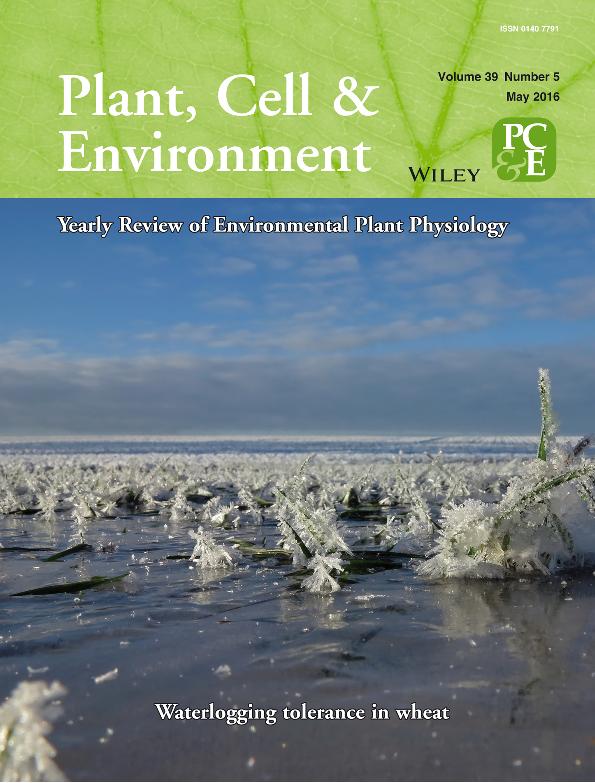Mostrar el registro sencillo del ítem
dc.contributor.author
Herzog, Max

dc.contributor.author
Striker, Gustavo Gabriel

dc.contributor.author
Colmer, Timothy D.

dc.contributor.author
Pedersen, Ole

dc.date.available
2017-06-05T14:47:01Z
dc.date.issued
2016-05
dc.identifier.citation
Herzog, Max; Striker, Gustavo Gabriel; Colmer, Timothy D.; Pedersen, Ole; Mechanisms of waterlogging tolerance in wheat - a review of root and shoot physiology; Wiley; Plant, Cell And Environment; 39; 5; 5-2016; 1068-1086
dc.identifier.issn
0140-7791
dc.identifier.uri
http://hdl.handle.net/11336/17468
dc.description.abstract
We review the detrimental effects of waterlogging on physiology, growth and yield of wheat. We highlight traits contributing to waterlogging tolerance and genetic diversity in wheat. Death of seminal roots and restriction of adventitious root length due to O2 deficiency result in low root:shoot ratio. Genotypes differ in seminal root anoxia tolerance, but mechanisms remain to be established; ethanol production rates do not explain anoxia tolerance. Root tip survival is short-term, and thereafter, seminal root re-growth upon re-aeration is limited. Genotypes differ in adventitious root numbers and in aerenchyma formation within these roots, resulting in varying waterlogging tolerances. Root extension is restricted by capacity for internal O2 movement to the apex. Sub-optimal O2 restricts root N uptake and translocation to the shoots, with N deficiency causing reduced shoot growth and grain yield. Although photosynthesis declines, sugars typically accumulate in shoots of waterlogged plants. Mn or Fe toxicity might occur in shoots of wheat on strongly acidic soils, but probably not more widely. Future breeding for waterlogging tolerance should focus on root internal aeration and better N-use efficiency; exploiting the genetic diversity in wheat for these and other traits should enable improvement of waterlogging tolerance.
dc.format
application/pdf
dc.language.iso
eng
dc.publisher
Wiley

dc.rights
info:eu-repo/semantics/openAccess
dc.rights.uri
https://creativecommons.org/licenses/by-nc-sa/2.5/ar/
dc.subject
Wheat (Triticum Aestivum)
dc.subject
Flooding Tolerance
dc.subject
Genotypic Variation
dc.subject
O2 Deficiency Recovery Ability
dc.subject.classification
Agricultura

dc.subject.classification
Agricultura, Silvicultura y Pesca

dc.subject.classification
CIENCIAS AGRÍCOLAS

dc.title
Mechanisms of waterlogging tolerance in wheat - a review of root and shoot physiology
dc.type
info:eu-repo/semantics/article
dc.type
info:ar-repo/semantics/artículo
dc.type
info:eu-repo/semantics/publishedVersion
dc.date.updated
2017-06-02T17:32:54Z
dc.journal.volume
39
dc.journal.number
5
dc.journal.pagination
1068-1086
dc.journal.pais
Estados Unidos

dc.journal.ciudad
Hoboken
dc.description.fil
Fil: Herzog, Max. Universidad de Copenhagen; Dinamarca. University of Western Australia; Australia
dc.description.fil
Fil: Striker, Gustavo Gabriel. Consejo Nacional de Investigaciones Científicas y Técnicas. Oficina de Coordinación Administrativa Parque Centenario. Instituto de Investigaciones Fisiológicas y Ecológicas Vinculadas a la Agricultura. Universidad de Buenos Aires. Facultad de Agronomía. Instituto de Investigaciones Fisiológicas y Ecológicas Vinculadas a la Agricultura; Argentina. University of Western Australia; Australia
dc.description.fil
Fil: Colmer, Timothy D.. University of Western Australia; Australia
dc.description.fil
Fil: Pedersen, Ole. Universidad de Copenhagen; Dinamarca. University of Western Australia; Australia
dc.journal.title
Plant, Cell And Environment

dc.relation.alternativeid
info:eu-repo/semantics/altIdentifier/doi/http://dx.doi.org/10.1111/pce.12676
dc.relation.alternativeid
info:eu-repo/semantics/altIdentifier/url/http://onlinelibrary.wiley.com/doi/10.1111/pce.12676/abstract
Archivos asociados
